Several housing booms after about 1917 brought us comfortable houses that are decidedly not Craftsman Bungalows. Indeed, in much of the USA, an “old house” refers to one built in the 1920s or later. Some of these houses belong to an obvious genre—Colonial, Modernist, Tudor. Others are weird suburban mash-ups. In decorating, what falls between Arts & Crafts and Bauhaus? n Art Deco, the style most associated with the Jazz Age, never made it to the residential mainstream. Householders usually opted for a plush, romantic look; think of those Hollywood movies offering an antidote to the Depression years. Eclectic rooms featured colorful fabrics, provocative art, faux finishes, and troweled plaster.
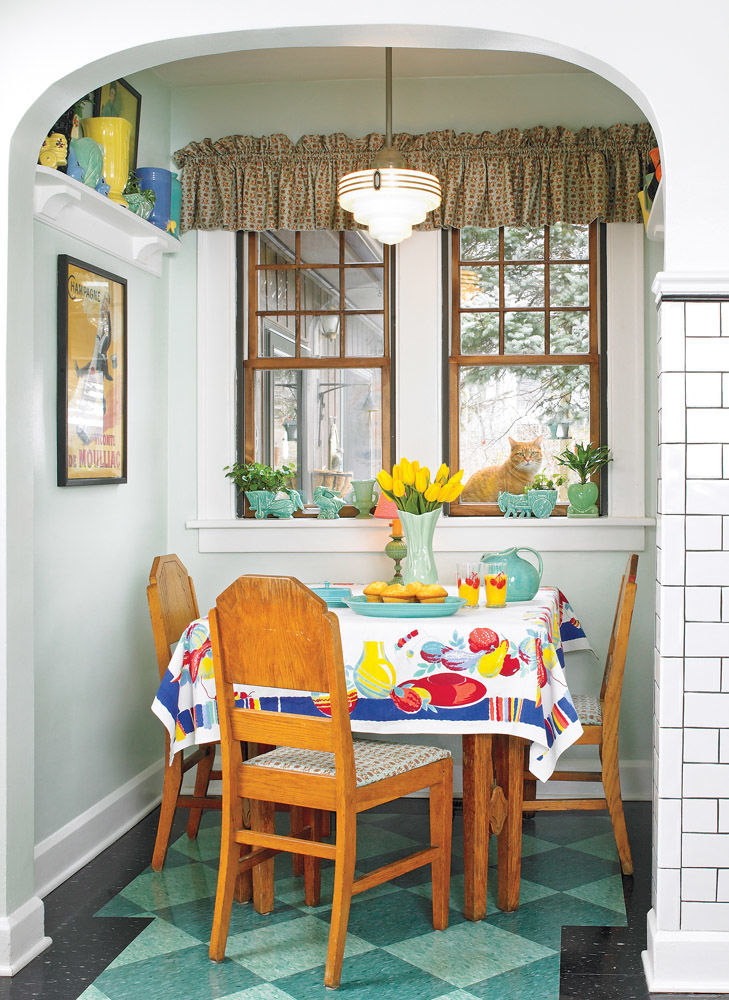
Collectibles of this period, including dishware and textiles, are abundant. The blue-green pottery cued the colors in the kitchen. Vinyl composition tile was cut and laid to look like period linoleum. (Photo: Gridley + Graves)
The era saw tremendous social and technological changes, two major World Wars, and the Great Depression. Design was just as diverse and fractured, taking in the waning influence of Arts & Crafts, a pervasive Colonial Revival, historical European styles embraced by returning soldiers, the first of several Victorian revivals, and “modern” ideas from Art Deco and Surrealist to Hollywood Glam. Regarding interior decorating, a useful over-simplification might be this: If it wasn’t edgy, it was very, very homey.
Nevertheless, if you’re looking to decorate your 1920s or ’30s house with a nod to its period, you don’t have to choose between Art Deco and Granny style. You can mix a Stickley rocker and Depression glassware. You can place a Tiffany-style lamp on a Sheraton table. The style police won’t beat down your door. This era is not about period correctness.
Some common influences marked the interiors of almost all of these houses. First is a return of traditional elements such as columns, brick hearths, and classical trim. Many houses were built with European-inspired details, from arches between rooms to multi-pane sash in an oriel or a bay window. (Sometimes it’s hard to tell whether the arch was meant to suggest Tudor England or Moorish Spain.) In decorating, a “historical chic” was popular—schemes inspired by 18th-century Italy, say, or the reign of Louis XVI. The nostalgic Old Colonies style, a hybrid of English Art Movement and just-stirring Colonial Revival tastes, had given way to a more correct, classical Colonial Revival, which became “Early American” after the restoration of Williamsburg in 1937.
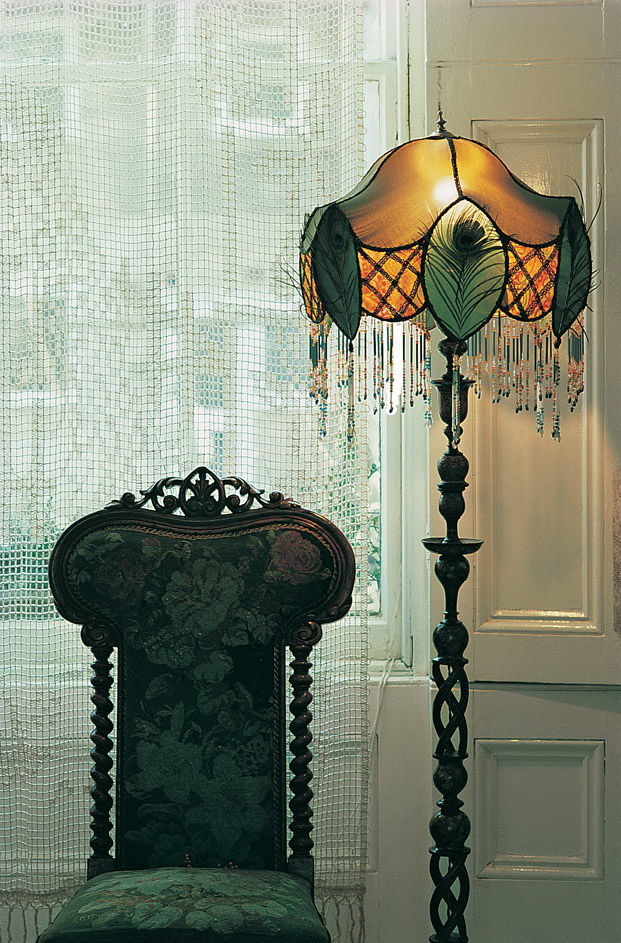
A beaded lampshade and a period-revival chair with tapestry upholstery create a Jazz Age vignette.
“After the First War, there was a sea-change in interiors,” writes decorative-arts historian Dan Cooper. “The Arts & Crafts Movement had paved the way for the Romantic Revivals, most notably those of the Tudor and Mediterranean styles, which had been lurking in the cupboard since 1900 and were now sweeping through the suburbs like an architectural brushfire.
“Suddenly every wall was troweled with rough or textured plaster. Textures ranged from a plain sanded surface to something one might call Volcanic Crater.”
That textured plaster suggested Old World homes, as did beamed, coffered, and “Jacobean” (strapwork) ceilings. Coved ceilings were in vogue. (The concave arc of plaster might be treated as part of the wall, or part of the ceiling, for different effects.) In wallpaper, stripes, florals, and small Colonial-style prints were popular; oatmeal and tapestry papers lent texture.
For furniture, loose interpretations of historical styles were favored: Tudor and Jacobean, Queen Anne, and Spanish Renaissance. Heirlooms, Mission pieces, or a Modern Movement accent might be thrown into the mix. Painted furniture was popular, often with decals or stencils, in exotic polychromed “Egyptian” or red-lacquered “Oriental” styles. If a mahogany-veneer buffet had cabriole legs, it was classified Queen Anne; a similar piece with heavy, turned legs was called Tudor.
“Favorite furniture styles,” adds interior-design historian John Burrows, “included Sheraton chairs, tables, and sideboards; Windsor chairs; Empire tables, tufted Chesterfield sofas; and slipcovered wing chairs.” Fabrics ran to plain silks and linens, patterned chintz in the English style, and rich-toned velvets.
Lighting design came into its own between the Wars, when colorful and ornamental fixtures replaced the utilitarian electric lights of the early 1900s. Look for Art Deco and Streamline designs; painted glass shades; blowsy, pieced-fabric lampshades dripping with gimp; and graceful bridge lamps.
Rooms of this period have been called High Pastiche—not parody, but rather imitation in honor of the past. In many cases, the homage mixes various styles and periods to become something distinct, and very much of the era.
Historical Revival & Bric-a-brac
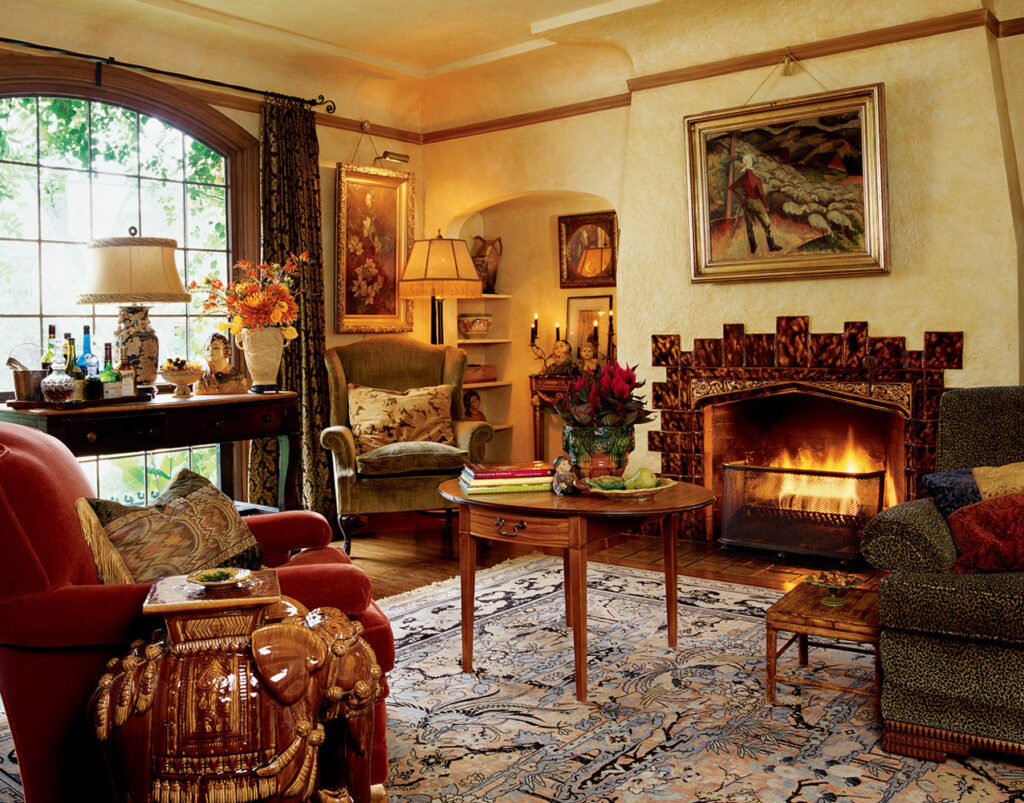
A luxurious drapery fabric set the tone for a period makeover for the interior of a 1929 Storybook Tudor house in Portland, Oregon. Fireplace tiles were treated to a gold-leaf and tortoise-shell finish. (Photo: Blackstone Edge Studios)
Touched by Hollywood glamour and Modernism, the decorating style that emerged in the Twenties was also quaintly historical, embracing every revival from Tudor to Pueblo.
Furnish with vintage furniture, rugs, and lighting. Go plush with wing chairs and textiles. Stun with a bit of Art Deco—or find a spot for a Rococo rosewood étagère. A theatrical room might glow with Victorian, Regency, classical Greek, and even Chinese elements.
Period-perfect decorating: English Cottage on the Lake
The Color Palette
Jazz Age colors of the Twenties came in romantic palettes of pink, green, and mauve, with accents in Chinese red or butterscotch yellow. Pastels were saturated, not the greyed tones of Arts & Crafts. Woodwork was left natural or painted in Colonial Revival off-whites. Depression-era colors of the 1930s were clear and lively: lilac and lavender, seafoam and mint green, orange and coral.
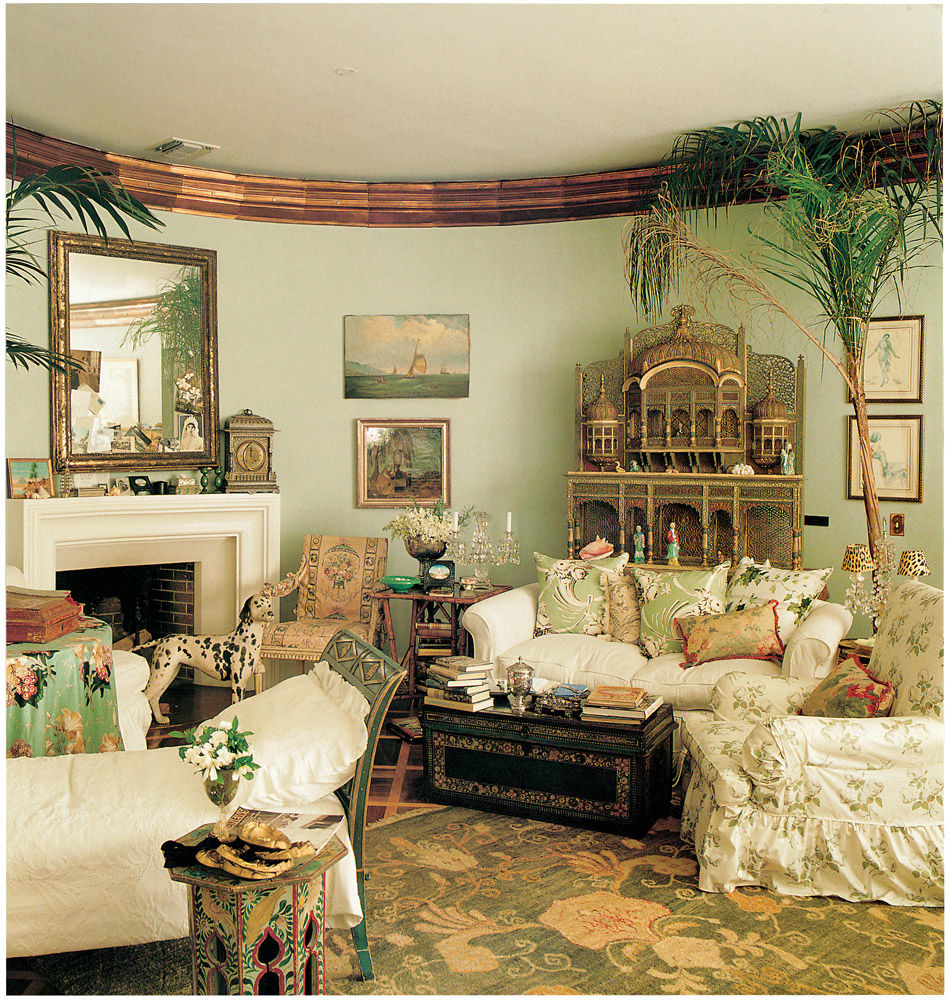
Clear mint green was a favorite pastel in these years; furnishings in the room come from Africa and the Orient. (Photo: From Retro Home, courtesy Rizzoli)
Palettes are more prescriptive for houses built with a strong affinity for a particular style. Pastel yellows and blues, for example, are common in Colonial Revival houses, while rich terra cotta and turquoise turn up in Spanish architecture. Art Deco colors are bright and deep, and often used as an accent with black, white, grey, and metallics.
The Era
Modernism was on the rise, but had little effect on most residential building. Instead, house styles made a conservative return to tradition and revival. Builders’ plan books laid out such offerings as Dutch Colonial, Spanish Mission, and English Tudor. “Houses in the 1920s reflect a return to historical revivals,” historian John Burrows says, “and the rooms inside them exhibit the same eclecticism as the era’s neighborhoods.”
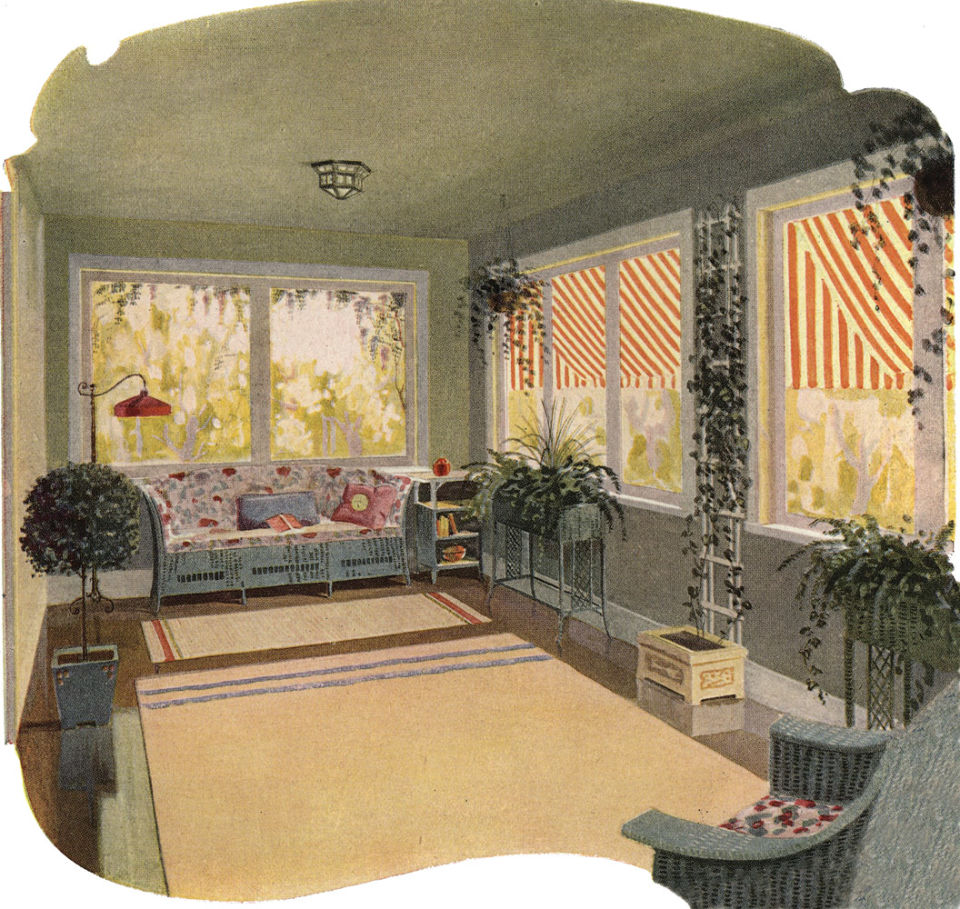
Casual sunrooms are familiar still. The illustration is from a 1926 house-plans book. (Photo: Gordon Van Tine Homes Catalog, 1926)
The builder’s intention and a whiff of the times remain in certain leitmotifs that can be found across several period styles—arched doorways, troweled plaster, sun parlors and French doors, Colonial Revival mantels. These are elements to preserve, whatever your decorating approach. Take a cue from the house, but rest assured that this era grants permission to mix it up.
High Pastiche
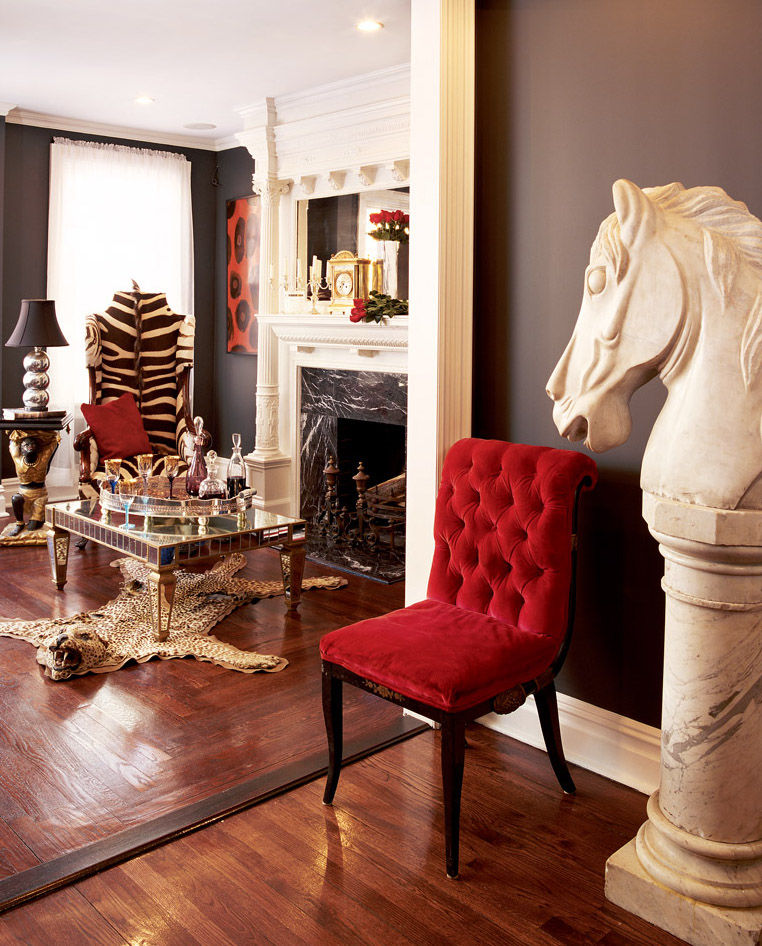
Tufted chairs, animal skins, and silver accents are luxe, exotic, and graphic. The marble horse’s head is 1920s Chinese. Mirrored furniture is from the 1940s. (Photo: Dan Mayers)
One of the best descriptions of this style period comes from Howard Mandelbaum and Eric Myers in their book Forties Screen Style (St. Martin’s Press, 1989). “High Pastiche, a wildly eclectic style,” they say, “is the blend of motifs and design factors that the movies elaborated into the architecture of dreams.” The style is modern, yet plush and layered—these are not the frozen rooms of Art Deco, a style that even in its heyday was rare in residential interiors.







